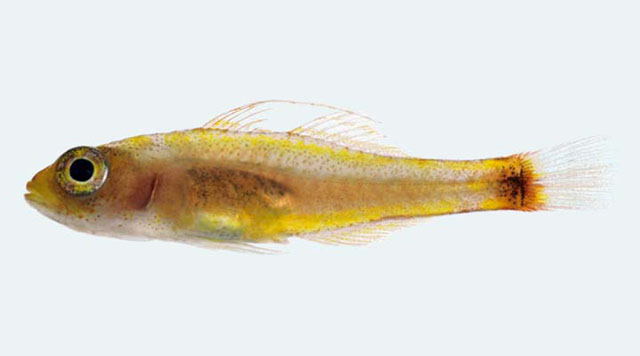| Gobiidae (Gobies), subfamily: Gobiinae |
| 2.25 cm SL (male/unsexed); 1.97 cm SL (female) |
|
demersal; marine; depth range 0 - 41 m |
| Western Pacific: Solomon Islands, Papua New Guinea, Indonesia, Vanuatu, Fiji, New Caledonia, Australia, the Philippines, and Palau. |
|
Dorsal spines (total): 7-7; Dorsal soft rays (total): 8-8; Anal spines: 1-1; Anal soft rays: 7-9. Diagnosis: Predorsal scales and a bony interorbital about pupil diameter in width. Second dorsal spine elongated. Fifth pelvic fin ray branched dichotomously once and 50-60% of the fourth. Scales on cheek absent; one or two scales on the upper opercle; usually 4-5 rows of scales anterior to the pelvic fin base. A large spot over the hypural region of the caudal peduncle; a dark area along the side of the body caused by peritoneal pigmentation. In all specimens, but that from Palau and New Caledonia, there is a thin, dark stripe from the upper lip to the mid region of the interorbital when preserved (white in life), a broad rounded ridge on the snout and anterior interorbital region, and a nasal sac with a tubular anterior opening and a pore-like posterior opening with a raised rim (Ref. 55345); characterized further by having longitudinal scale series 23-24; predorsal scales 5-7; depth of body 4.3-4.6 in SL (Ref. 90102). |
| Cryptobenthic, epibenthic. Collected on drop-offs, either sloping or vertical with caves. Apparently tends to congregate in loose schools close to the shelter of caves and sea fans, to which they retreat when approached, and seem to be most abundant at about 20 meter depth range. Often form mixed schools with Trimma tevegae (Ref. 55345). |
|
Least Concern (LC); Date assessed: 11 March 2015 Ref. (130435)
|
| harmless |
Source and more info: www.fishbase.org. For personal, classroom, and other internal use only. Not for publication.

